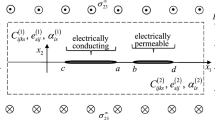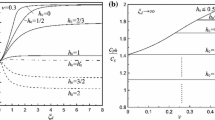Abstract
The asymptotic problem of a semi-infinite interface crack between dissimilar electrostrictive materials that are subjected to electric loading is numerically analyzed by using the finite element method. Numerical results of electric displacement fields are obtained on the basis of the mathematical equivalence of the mode III problem and an electrostatic problem. The shape and the size of saturation zones are explored as a function of the ratio of the saturated electric displacements of dissimilar electrostrictive materials. In contrast with conventional wisdom, the ratio of the permittivities is shown to exert a negligibly small influence on electric displacement fields. For various combinations of the material properties of dissimilar electrostrictive materials, stress fields and stress intensity factors are systemically calculated by using the numerical results of electric displacement fields. The effects of the electric, elastic, and electrostrictive properties on stress intensity factors are demonstrated.
Similar content being viewed by others
References
Beom H.G.: Small scale nonlinear analysis of electrostrictive crack problems. J. Mech. Phys. Solids 47, 1379–1395 (1999)
Beom H.G., Kim Y.H., Cho C., Kim C.B.: A crack with an electric displacement saturation zone in an electrostrictive material. Arch. Appl. Mech. 76, 19–31 (2006)
Beom H.G., Kim Y.H., Cho C., Kim C.B.: Asymptotic analysis of an impermeable crack in an electrostrictive material subjected to electric loading. Int. J. Solids Struct. 43, 6869–6886 (2006)
Beom H.G., Kim Y.H., Cho C., Kim C.B.: Modified boundary layer analysis of an electrode in an electrostrictive material. Arch. Appl. Mech. 78, 191–209 (2008)
Champion C.R., Atkinson C.: A mode III crack at the interface between two nonlinear materials. Proc. R. Soc. Lond. A 429, 247–257 (1990)
Gong X., Suo Z.: Reliability of ceramic multilayer actuators: A Nonlinear finite element simulation. J. Mech. Phys. Solids 44, 751–769 (1996)
Guo Q., Keer L.M.: A crack at the interface of two power-law hardening materials—antiplane case. J. Mech. Phys. Solids 38, 183–194 (1990)
Hao T.H., Gong X., Suo Z.: Fracture mechanics for the design of ceramic multilayer actuators. J. Mech. Phys. Solids 44, 23–48 (1996)
Ru C.Q., Mao X., Epstein M.: Electric field induced interfacial cracking in multilayer electrostrictive actuators. J. Mech. Phys. Solids 46, 1301–1318 (1998)
Saif M.T.A., Hui C.-Y.: Near tip fields for a stationary mode III crack between a linear elastic and an elastic power law hardening material. Int. J. Fract. 64, 1–26 (1993)
Suo Z.: Singularities interacting with interfaces and cracks. Int. J. Solids Struct. 25, 1133–1142 (1989)
Uchino K., Furuta A.: Destruction mechanism of multilayer ceramic actuators. Proc. ISAF 1992, 195–198 (1992)
Wang B.-L., Mai Y.-W.: Impermeable crack and permeable crack assumptions, which one is more realistic. J. Appl. Mech. 71, 575–578 (2004)
Winzer S.R., Shankar N., Ritter A.P.: Designing cofired multilayer electrostrictive actuators for reliability. J. Am. Ceram. Soc. 72, 2246–2257 (1989)
Yang W., Suo Z.: Cracking in ceramic actuators caused by electrostriction. J. Mech. Phys. Solids 42, 649–663 (1994)
Author information
Authors and Affiliations
Corresponding author
Rights and permissions
About this article
Cite this article
Kim, Y.H., Beom, H.G. Stress intensity factors for an interface crack with impermeable surfaces between dissimilar electrostrictive materials. Arch Appl Mech 80, 1287–1300 (2010). https://doi.org/10.1007/s00419-009-0371-5
Received:
Accepted:
Published:
Issue Date:
DOI: https://doi.org/10.1007/s00419-009-0371-5




